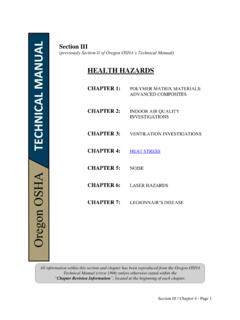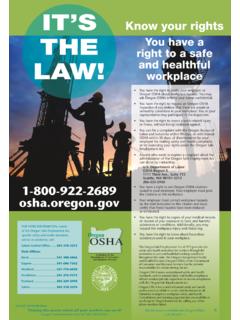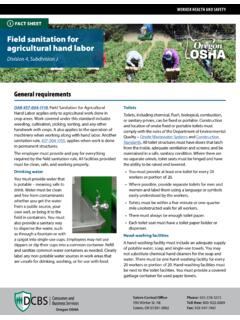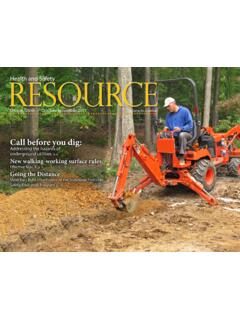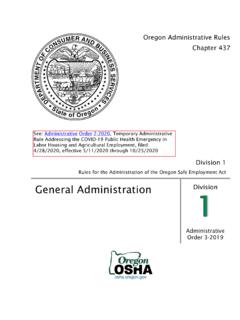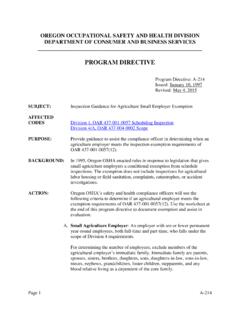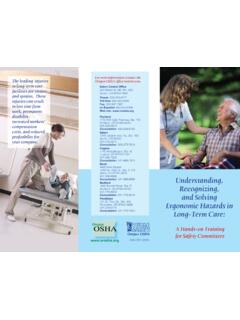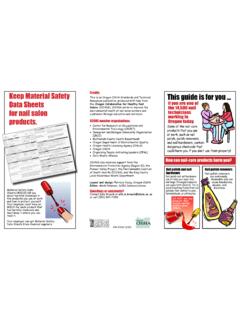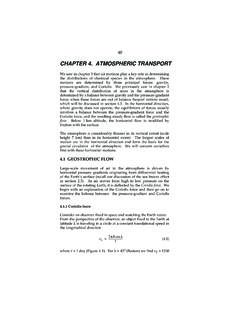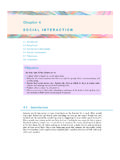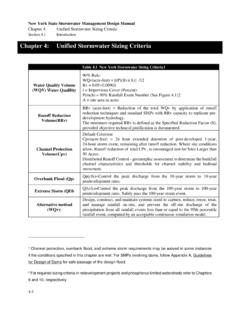Transcription of CHAPTER 2: CHAPTER 3: CHAPTER 4 - …
1 Section IV / CHAPTER 2 - Page 1 Section IV (previously Section III of Oregon OSHA s Technical Manual) SAFETY HAZARDS CHAPTER 1: OILWELL DERRICK STABILITY: GUYWIRE ANCHOR SYSTEMS CHAPTER 2: PETROLEUM REFINING PROCESSES CHAPTER 3: PRESSURE VESSEL GUIDELINES CHAPTER 4: INDUSTRIAL ROBOTS AND ROBOT SYSTEM SAFETY Section IV / CHAPTER 2 - Page 2 SECTION IV: CHAPTER 2 PETROLEUM REFINING PROCESSES CHAPTER Revision Information: This CHAPTER was previously identified as Section III, CHAPTER 2 in Oregon OSHA s circa 1996 Technical Manual.
2 The section number was modified from Section III to Section IV in March 2014 to provide uniformity with federal OSHA s Technical Manual (OTM). In March 2014, the CHAPTER s multilevel listing format was modified from an alphanumeric system to a roman numeral system. In March 2014, several figures were updated for clarity. All content remains the same. Section IV / CHAPTER 2 - Page 3 SECTION IV: CHAPTER 2 PETROLEUM REFINING PROCESSES TABLE OF CONTENTS I. INTRODUCTION .. 4 II. OVERVIEW OF THE PETROLEUM INDUSTRY .. 4 A. Basic Refinery Process .. 4 B. Basics of Crude Oil.
3 8 C. Basics of Hydrocarbon Chemistry.. 9 D. Major Refinery Products .. 14 E. Common Refinery Chemicals .. 15 III. PETROLEUM REFINING OPERATIONS .. 16 A. Introduction .. 16 B. Refining Operations .. 16 IV. DESCRIPTION OF PETROLEUM REFINING PROCESSES AND RELATED HEALTH AND SAFETY CONSIDERATIONS .. 19 A. Crude Oil (Desalting) .. 19 B. Crude Oil Distillation (Fractionation) .. 21 C. Solvent Extraction and Dewaxing .. 24 D. Thermal Cracking .. 27 E. Catalytic Cracking .. 32 F. Fluid Catalytic Cracking .. 33 G. Hydrocracking .. 35 H. Catalytic Reforming.
4 38 I. Catalytic Hydrotreating .. 40 J. Isomerization .. 42 K. Polymerization .. 45 L. Alkylation .. 47 M. Sweetening and Treating Processes .. 50 N. Unsaturated Gas Plants .. 52 O. Amine Plants .. 53 P. Saturated Gas Plants .. 54 Q. Asphalt Production .. 55 Section IV / CHAPTER 2 - Page 4 TABLE OF CONTENTS (CONTINUED) R. Hydrogen Production .. 56 S. Blending .. 57 T. Lubricant, Wax, and Grease Manufacturing .. 58 V. OTHER REFINERY OPERATIONS .. 59 A. Heat Exchangers, Coolers, and Process Heaters .. 59 B. Steam Generation .. 60 C. Pressure Relief and Flare Systems.
5 62 D. Wastewater Treatment .. 64 E. Cooling Towers .. 65 F. Electric Power .. 66 G. Gas and Air Compressors .. 67 H. Marine, Tank Car, and Truck Loading and Unloading .. 67 I. Turbines .. 68 J. Pumps, Piping and Valves .. 69 K. Tank Storage .. 70 VI. BIBLIOGRAPHY .. 71 LIST OF APPDENENDICES APPENDIX: 2-1 Glossary .. 73 Section IV / CHAPTER 2 - Page 5 I. Introduction The petroleum industry began with the successful drilling of the first commercial oil well in 1859, and the opening of the first refinery two years later to process the crude into kerosene.
6 The evolution of petroleum refining from simple distillation to today's sophisticated processes has created a need for health and safety management procedures and safe work practices. To those unfamiliar with the industry, petroleum refineries may appear to be complex and confusing places. Refining is the processing of one complex mixture of hydrocarbons into a number of other complex mixtures of hydrocarbons. The safe and orderly processing of crude oil into flammable gases and liquids at high temperatures and pressures using vessels, equipment, and piping subjected to stress and corrosion requires considerable knowledge, control, and expertise.
7 Safety and health professionals, working with process, chemical, instrumentation, and metallurgical engineers, assure that potential physical, mechanical, chemical, and health hazards are recognized and provisions are made for safe operating practices and appropriate protective measures. These measures may include hard hats, safety glasses and goggles, safety shoes, hearing protection, respiratory protection, and protective clothing such as fire resistant clothing where required. In addition, procedures should be established to assure compliance with applicable regulations and standards such as hazard communications, confined space entry, and process safety management.
8 This CHAPTER of the technical manual covers the history of refinery processing, characteristics of crude oil, hydrocarbon types and chemistry, and major refinery products and by-products. It presents information on technology as normally practiced in present operations. It describes the more common refinery processes and includes relevant safety and health information. Additional information covers refinery utilities and miscellaneous supporting activities related to hydrocarbon processing. Field personnel will learn what to expect in various facilities regarding typical materials and process methods, equipment, potential hazards, and exposures.
9 The information presented refers to fire prevention, industrial hygiene, and safe work practices, and is not intended to provide comprehensive guidelines for protective measures and/or compliance with regulatory requirements. As some of the terminology is industry-specific, a glossary is provided as an appendix. This CHAPTER does not cover petrochemical processing. II. Overview of the Petroleum Industry A. Basic Refinery Process: Description and History Petroleum refining has evolved continuously in response to changing consumer demand for better and different products.
10 The original requirement was to produce kerosene as a cheaper and better source of light than whale oil. The development of the internal combustion engine led to the production of gasoline and diesel fuels. The evolution of the airplane created a need first for high-octane aviation gasoline and then for jet fuel, a sophisticated form of the original product, kerosene. Present-day refineries produce a variety of products including many required as feedstocks for the petrochemical industry. Section IV / CHAPTER 2 - Page 6 1. Distillation Process The first refinery, opened in 1861, produced kerosene by simple atmospheric distillation.
